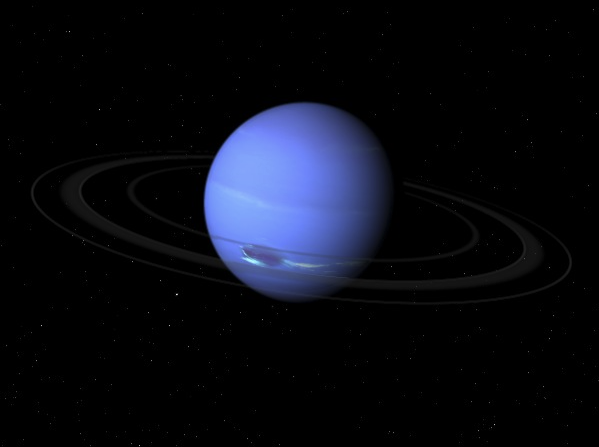Neptune, that blue gas giant so far from our home planet, has fascinated many people, from philosophers to scientists and space engineers. Many scientists have wondered about
Neptune surface, and we are still trying to figure out its secrets. But we do know something already, so let’s dig deeper to see what its layers are made of, what explains its blue hue, and what makes this planet so special.
Quick Facts about Blue Giant
Down here on Earth, we can’t see the Blue Giant with the naked eye because this ice giant is located around 4.5 billion km from our planet. A solar day on this planet is 0.6713 Earth days, whereas a year on the blue giant lasts 164.8 Earth years. Neptune, associated with the Roman Sea God, was first discovered based on pure Math calculations.
Galileo Galilei spotted it first with a primitive telescope back in 1612-1613.
What are Neptune's layers made of?
This planet has a complex inner structure composed of metals, and a silicate core, with methane and a mantle made of frozen ammonia. Blue Giant’s atmospheric layers consist mainly of helium and methane, so it’s a gaseous one. Like other gaseous giants, the Blue Ice Giant doesn’t have a solid surface layer. Instead, its gas forms a water layer and becomes slushy ice. This ocean of liquid ammonia acts as this planet’s surface and is 10 times our planet’s mass. Since this planet doesn’t have a hard layer, its surface area can’t be accurately studied or determined.
What is the blue stuff on Neptune?
Neptune's surface temperature determines changes and reactions happening in Neptune's surface composition. From looking at the pictures, this planet appears blue (which is how it got its name), but this look is deceiving and is mainly an optical illusion. The planet’s upper atmosphere’s methane absorbs our Sun’s red light but keeps reflecting the blue one from here back into space. For this reason, Neptune’s surface appears blue when seen through our planet’s equipment. Probably the most recognizable Neptune surface images were captured about 35 years back, precisely in June 1989. Its reflected light doesn’t come from a solid surface like it does on Earth but from the planet’s gaseous atmosphere.
Is there water on Neptune's surface?


Probably yes, although not quite in the same form as we’re used to. According to
Orbital Today, there is more than one theory supporting the presence of water on Neptune’s surface. Here are some of them:
- Water comes from comets and asteroids, which are made of ice; as they enter the Solar system’s inner part and Neptune's atmosphere, colliding with the planet. When this happens, icy materials fall on a planetary surface.
- Water forms because there are certain chemical processes occur in the planet’s inner layers, particularly – chemical reactions in its planetary mantle.
- Planetary pressure, combined with its surface temperature, creates conditions in which hydrogen forms new compounds with oxygen and water.
What is special in Neptune?
Neptune's size is not the only impressive fact about this planet. The Blue Giant may be the windiest place in our
solar system, as supersonic winds constantly rage on its surface. There’s always an extremely dynamic storm here, and winds reach 600m/s speed. Since Neptune’s mass is approximately 1.0243×10^26 kg and its average radius is about 24,622 km, this planet’s gravity is 11.15 m/s^2. This value is 14% more than the Earth’s, which is 9.8 m/s^2.
If you stood on Neptune's surface as you could on planet Earth, you would be 14% heavier, which would increase your free fall speed by 11.5 m/s. This figure is average and doesn’t account for all possible deviations inside Neptune’s gravity field. At various depths, gravity is different than at the planet’s surface, which is explained by differences in pressure and density.
How hot is Neptune?
Neptune is not a warm planet. On the contrary, it’s cold and dark. Most of the time, the temperature on Neptune's surface is -330°F. At its core, this planet reaches 12632 °F, like on the Sun’s surface. The differences in temperatures between Neptune’s surface and its centre generate huge windstorms that can reach the speed of 2,100 km/hour. These are the fastest wind speeds we know so far. Because of these conditions, humans could not survive on this planet’s surface – not without special equipment, at least. Besides, as a gas and ice giant, Neptune doesn’t have a solid rocky surface, so we would not be able to ‘stand’ on its surface like we’re used to.
Neptune's atmosphere has two main ‘areas’, the innermost: troposphere and stratosphere. In the latter, temperature decreases with altitude, whereas in the former, it increases. However, none of the facts we have established so far make this planet suitable for manned exploration.
Still, we keep sending unmanned probes to Neptune’s surface and keep discovering new data about this fascinating blue giant. So, who knows? One day, when our tech allows it, we could actually ‘step’ on its surface.
Author: Emma Thorpe

 Probably yes, although not quite in the same form as we’re used to. According to Orbital Today, there is more than one theory supporting the presence of water on Neptune’s surface. Here are some of them:
Probably yes, although not quite in the same form as we’re used to. According to Orbital Today, there is more than one theory supporting the presence of water on Neptune’s surface. Here are some of them: